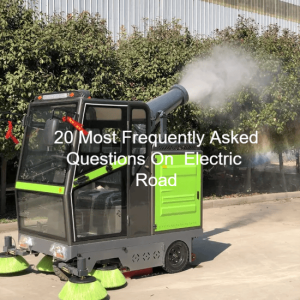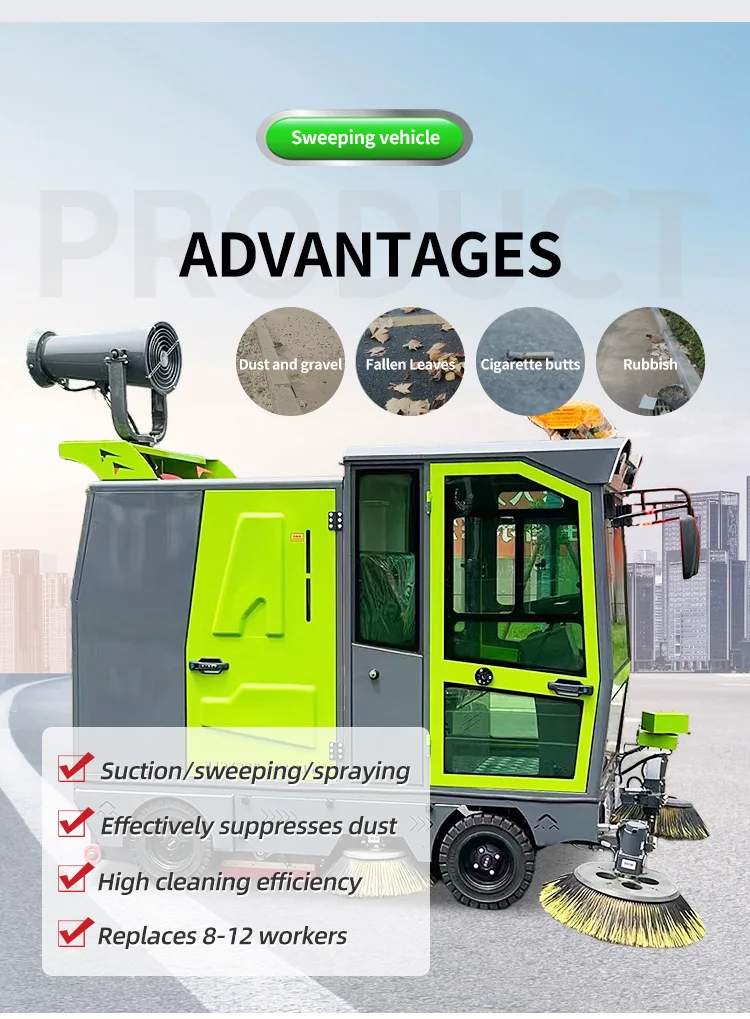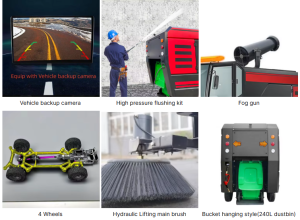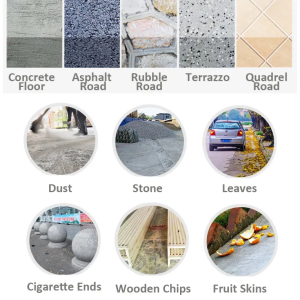Electric road sweepers are becoming increasingly popular due to their eco-friendly nature and efficiency in urban cleaning. Electric street sweepers are revolutionizing city maintenance by offering an eco-friendly, quiet, and efficient solution for keeping our cities clean. Here are the 20 most frequently asked questions about electric road sweepers:

Other names for electric street sweepers include mini electric road sweeper, road sweeper, electric, vacuum road sweepers, electric street sweeper truck, electric hybrid street sweeper, electric street machine, wet sweepers, road sweepers, new energy road sweepers, and ride-on sweepers, floor cleaning machine, cleaning equipment, sweeper, cleaner, industrial sweeper,snow sweeper, vacuum sweeper, floor sweeper machine, cleaning sweeper cleaning tool, electric road sweeping truck, electric vacuum road sweeper, mini electric road sweeper .street sweep electric term, street sweeper electric water pumps,electric three-wheeled washing and sweeping vehicle.
| Component Name | Project | Electric Street specification |
| electrical street sweeper complete vehicle | Model | G25D |
| Sweeping width | 2500mm | |
| Main brush width | 800mm | |
| working efficiency | 20000-35000m2/h | |
| working hours | 3-8h | |
| Dustbin capacity | 220L | |
| Side brush diameter | 700/600mm | |
| Walking speed | 0-14km/h | |
| Overall dimensions | 3500*2500*2730mm | |
| water tank | 300L | |
| Vacuum filtration area | 10m2 | |
| Tyre type | Front 400-8,rear 400-10 solid tyre | |
| control mode | Intelligent control system(timed dust shaking function) | |
| electrical street sweeper warning lights | Headlight | Four way lED headlights |
| tail light | Steering+braking+driving integrated tail lights | |
| Alarm lamp | Top operation warning light | |
| electrical street sweeper storage battery | Type | Lead acid maintenance free (optional with lithium battery) |
| Battery capacity | Standard 48V-150AH*6/200AH*8/240ah*8 lead-acid battery | |
| electrical street sweeper electrical machinery | Walking motor | 2200w intelligent gear change |
| Rolling brush motor | 1000W | |
| Side-brush motor | 4*100W | |
| Motor voltage | 48V | |
| electrical street sweeper rearview mirror | Model | Dedicated for sweeping vehicles |

The specifications of electric road sweepers can be influenced by several factors:
Electric road sweeper specifications are shaped by a variety of factors, including intended use, battery technology, environmental regulations, terrain conditions, maintenance needs, user requirements, market trends, and cost considerations. Understanding these influences can help manufacturers and buyers select the best model for their specific needs.
An electric road sweeper is a vehicle designed to clean streets, roads, and other surfaces using electric power instead of traditional fossil fuels. It is equipped with brushes, vacuums, and filters to collect debris and dust. An electric street sweeper is designed to efficiently clean streets and pavements using a combination of mechanical and hydraulic systems. Here’s a breakdown of how it works, including the components you’ve mentioned:
The sweeper is powered by electric motors, which reduce emissions and noise compared to traditional fuel-powered models.
This safety feature helps the operator see behind the vehicle when reversing, reducing the risk of accidents.
This system uses high-pressure water jets to dislodge dirt and debris from surfaces. It’s typically integrated with the main sweeping mechanism, allowing for thorough cleaning.
The sweeper is equipped with four wheels for stability and mobility. The design allows for easy navigation on various terrains.
The main brush is lifted and lowered using hydraulic systems. This allows the operator to adjust the brush height depending on the surface being cleaned, ensuring effective sweeping without damaging the ground.

Electric operation minimizes environmental impact.
Backup cameras enhance operational safety.
Battery life typically ranges from 8 to 10 hours, depending on the model and usage. Some sweepers offer swappable batteries for extended operation.
Preparation:
Sweeping:
Backup and Maneuvering:
Post-Cleaning:
Henan HuayuJujiu Vehicle Co., Ltd is one of China’s best electric road sweeper manufacturers.
Henan HuayuJujiu Vehicle Co., Ltd is a special-purpose vehicle manufacturer approved by the Chinese government. Founded in 2001. Located in the city of Jiaozuo, county Wuzhi, Henan province,
Yes, most electric sweepers are designed to handle both wet and dry debris, including leaves, sand, gravel, and litter.
Yes, but the suitability depends on the battery life and storage capacity. Larger models are designed for extensive areas, while smaller ones are better for confined spaces.
Storage capacities vary, but most models can hold between 0.5 to 3 cubic meters (17 to 105 cubic feet) of debris.
Yes, electric sweepers operate significantly quieter, making them ideal for noise-sensitive areas like residential neighborhoods or early morning cleaning.
Maintenance includes regular cleaning of brushes and filters, checking battery health, and ensuring the vacuum system is functioning properly. Electric sweepers generally require less maintenance than diesel models.
Prices vary widely depending on electric street sweeper size and features brand and after-sales etc .
Electric Street Sweepers – Efficient Cleaning Solutions
Price Of Road Sweeper Truck.

electric street sweeper cost :$12,300.00-12,400.00 Min. order: 1 set



💬 Leave a comment here!
📧 Email me: iris@hyjjgroup.com
📱 WhatsApp :+8617838749641
🌐 Website: https://www.hyjjvehicle.com/
📺 YouTube: https://www.youtube.com/@huayujujiusemitrailerfactory
Most electric sweepers are designed to operate in various weather conditions, but extreme cold or heavy rain may affect battery performance.
With proper maintenance, an electric road sweeper can last 8 to 10 years or more, depending on usage and care.
Yes, there are compact sweepers for sidewalks, medium-sized sweepers for urban streets, and large industrial sweepers for highways and construction sites.
Yes, their zero-emission operation makes them ideal for indoor use in places like warehouses, parking garages, and airports.
Many online sales companies and manufacturers will falsely mark the parameters of industrial-grade floor scrubbers, especially those trading companies and factories that did not start with cleaning equipment. There is a huge discrepancy between the actual parameters and the written parameters, so you must pay attention to distinguish them when purchasing.
The working environment of multi-functional road sweepers is considered the worst, and the failure rate is definitely higher than that in commercial places. Therefore, it is very important whether the machine is guaranteed nationwide. Timely technical guidance and door-to-door service can save a lot of time.
You must pay attention to the core components of the electric road sweeper machine, otherwise it will break down after a short period of use, and subsequent repair costs will greatly increase the cost of using the machine.
the price of a floor washing machine is closely related to the quality. Please do not buy the machine at a very low price, because you will get what you paid.
Many floor sweepers manufacturers do not specifically tell users that the consumables will be paid separately when selling machines, nor do they guarantee the service life of the consumables.
Basic training is required to operate the sweeper safely and efficiently, but the controls are typically user-friendly.
Road Sweeper Import Data and Export Data Road Sweeper. HS code table imports and exports
Road Sweeper Imports Exports as a percentage of India’s overall GDP. It is no wonder that ports have contributed significantly to the boom in this Power Sweeper industry and we understand better how to benefit from this popular opportunity. We understand the fact that many importing companies are actively sourcing different ranges of products, including raw materials, machinery, and consumer goods. Therefore, we offer comprehensive import data solutions as well as export data solutions for a wide range of categories of import trading companies and export trading companies.
Our Huayujujiu Road Sweeper import data and export data solutions fulfill your actual import and export requirements in terms of quality, quantity, seasonality and geographical location. Additionally, we help you get detailed information on important export and import areas including HS codes, product descriptions, tariffs, quantities, prices, etc. Huayujujiu Motorized Sweeper import/export data paves the way for successful collaborations that can generate profits for businesses locally and globally.
|
HS CODE |
Description |
|
84791000 |
Machinery for public works, building or the like(Electric Street Sweeper ) |
|
8479 |
Machines And Mechanical Appliances Having individual functions, Not specified or includedElsewhere In This chapter |
|
84798999 |
Other |
|
8707 |
Bodies (including Cabs), For The Motor Vehicles of Headings 8701 To 8705 |
|
87071000 |
For the vehicles of heading 8703 |
HS Code used for road sweeper machine___Export
| HS CODE |
DESCRIPTION |
NO Of Shipments |
| 8479 |
Machines And Mechanical Appliances Having Individual Functions, Not specified or includedElsewhere In This Chapter |
5000 |
|
84798999 |
other |
2000 |
|
8512 |
Electrical lighting or signaling Equipment (Excluding Articles of Heading 8539), windscreen wipersDefrosters And Dem |
300 |
|
85122010 |
Head lamps, tail lamps, stop lamps, side lamps and blinkers |
600 |
|
7326 |
Other Articles of lron Or steel |
700 |
|
73261990 |
Other |
800 |
|
4016 |
Other Articles of Vulcanised Rubber Other Than Hard Rubbel |
900 |
|
40169990 |
Other |
500 |
|
8302 |
Base Metal Mountings, fittings And similar Articles suitable For Furniture, Doors, staircases, WindowsBlinds, Coachwo |
300 |
|
83022000 |
Castors |
200 |
HS Code Used for road sweeper machine___import
The Harmonized System (HS) code for electric street sweepers typically falls under the category of “road sweeping machines.” The specific HS code can vary by country, but a common HS code for electric street sweepers is:
However, it’s essential to verify with your local customs authority or trade regulations for the exact code applicable in your region, as codes can differ by country and may be subject to updates.
Road Sweeper worth $786,616 under HS Code 84798999 have been imported
Average import price for road sweeper under HS Code 84798999 was $60,508.90. Please use filters at the bottom of the page to view and select unit type.
Road Sweeper under HS Code 84798999 were imported from 4 countries
South Korea was the largest exporter of road sweeper under HS Code 84798999 accounting for 72.03% of the total imports of road sweeper under HS Code 84798999
Italy was the second largest exporter of road sweeper under HS Code 84798999 accounting for 23.13% of the total imports of road sweeper under HS Code 84798999
Typical End-of-Life Considerations and Disposal/Recycling Options for Street Sweepers
When street sweepers reach the end of their operational life, it’s essential to manage their disposal responsibly to minimize environmental impact and recover valuable resources. Below are the key considerations and options for disposal and recycling:
Condition Assessment: Evaluate the street sweeper’s condition to determine the potential for part reuse or refurbishment.
Decommissioning: Safely disable the sweeper to prevent accidental operation during dismantling.
Fluid Drainage: Properly drain and dispose of fluids such as fuel, oil, hydraulic fluids, and coolants following environmental regulations.
Battery Disposal: Remove and recycle batteries, which contain hazardous materials, in accordance with local regulations.
Reusable Parts: Identify parts that can be refurbished or sold, such as engines, motors, and brushes.
Recyclable Materials: Separate materials like metals, plastics, and electronics for appropriate recycling processes.
Disposal and Recycling Options
Scrap Metal: Large metal components, such as the chassis and body panels, can be sold to scrap metal dealers.
Ferrous and Non-Ferrous Separation: Separate ferrous (iron and steel) from non-ferrous metals (aluminum, copper) for specialized recycling.
Plastic Components: Recycle plastic parts through facilities that process automotive plastics.
Tires and Rubber: Dispose of or recycle tires and other rubber components via tire recycling programs.
Electronic Components: Recycle electronic parts such as control systems, sensors, and circuit boards through certified e-waste recyclers.
Manufacturer Take-Back Programs: Some manufacturers offer take-back programs to ensure responsible recycling and disposal of old sweepers.
Government Programs: Utilize municipal or regional programs designed for disposing of large industrial equipment.
Sustainable Practices
Refurbishment: Consider refurbishing old sweepers for use in secondary markets or less demanding applications.
Repurposing: Adapt parts or systems for use in other industrial applications, extending their lifecycle.
Material Recovery: Focus on recovering valuable materials such as metals and rare earth elements from electronic components.
Energy Recovery: In some cases, non-recyclable materials can be processed in waste-to-energy facilities.
Environmental Compliance:
Compliance: Ensure all disposal and recycling activities comply with local, state, and federal environmental regulations.
Documentation: Maintain records of the disposal process to demonstrate compliance and for auditing purposes.
Minimize Waste: Implement practices to minimize waste generation during the disposal process.
Reduce Emissions: Choose recycling methods that reduce emissions and environmental footprint.
By following these considerations and options, municipalities and businesses can ensure the responsible end-of-life management of street
There are 20 tips about the application of electrical street sweeping vehicles.
so, there are many electric street sweeper application, for example, workshop, application, ground park, street,r oad, application ground, stone of brick, asphalt road, cement floor, plastic trash, concrete floor, rubble road, quadrel road, dust ston, cigarette ends, wooden chips, fruit shills, airport,gym. Please refer to the flowing 3 pictures introducing the application scenarios of electric washing and sweeping vehicles.




A: Headquartered in Jiaozuo Henan Province , China, the company has a good reputation in the automotive trading industry and serves customers worldwide.There are over 30000 vehicles traded online and offline, covering countries and regions such as Russia, Mongolia, Southeast Asia, Africa, and Central Asia.
To purchase from Huayujujiu Vehicle Co., Ltd., explore our comprehensive catalog on our website or share your specific requirements with our expert sales manager. They will recommend the perfect model tailored to your needs. Once the model and pricing are agreed upon, we will promptly proceed to sign the contract, ensuring a seamless and efficient transaction.
Firstly, we hold an international quality system certification, affirming our dedication to excellence. Secondly, our factory has undergone meticulous field certification by the Made in China Group. Lastly, you have the option to hire third-party individuals or organizations to conduct a thorough inspection of our products before delivery, guaranteeing the utmost quality.
Upon your arrival in China, you can fly directly to Xingzheng Airport in Zhengzhou City, Henan Province. Our courteous driver will warmly greet you and ensure a comfortable, convenient transport to our factory, making your journey as smooth as possible
We consistently provide a pre-production sample for your approval before proceeding with mass production. Additionally, we conduct thorough final inspections before shipment to ensure the highest standards are met, maintaining our commitment to quality.
A: Most of our trucks and machinery are readily in stock and can be delivered within a mere 7 days. For bespoke orders, production generally spans around 30 days.
A: We pride ourselves on producing nearly 30,000 units per year, with an impressive update of approximately 5,000 units every month.
A: Absolutely, we embrace custom orders with enthusiasm. Our minimum order quantity (MOQ) is conveniently set at just one unit, catering to various customer needs.
If any of our premium construction machinery piques your interest, please do not hesitate to contact us. We also warmly invite you to China to visit our construction machinery factory, discuss pricing, and delve further into the details of our offerings.
A: 12 Months, Any problem of components within warranty, we will express new one for free, except
batteries and wearing parts,after the warranty period, you can still enjoy our service all the time.
A: Firstly, we will supply the users manual together with Vehicle;
Secondly, we will send the operation Video;
Thirdly, if any question of the vehicle, you can make a picture or video for us,we will help you to fix
it immediately. and if necessary, we will help to send an engineer to your site.
A: For now, our Sanitation Vehicle Products are with maintenance-free battery, some models
are equipped with Lithium batteries.